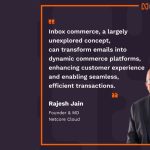Global marketing intelligence company, WARC, released its latest white paper titled ‘Rethinking Brand for the Rise of Digital Commerce’, which brings together the latest evidence to show why brand-building still matters as digital sales grow.
“We need to rethink brand-building and channel assumptions (as) the events of 2020 saw deep cuts to investment in marketing, and brand-building in general,” said VP Content, WARC, David Tiltman. “If we hold that a strong brand is key to the long-term health of businesses, marketers now face a profound risk to their reputation as drivers of growth.”

The white paper features analysis by former strategist and researcher, James Hurman, who sets out why marketers will need to plan brand and performance together to generate maximum impact, as well as interviews with leading CMOs, plus new research by Adgile, Amplified Intelligence, Analytic Partners, the Ehrenberg-Bass Institute, Facebook, Flywheel Digital, Wavemaker and more.
“With this white paper we bring together the latest evidence to help marketers continue to understand the role of brand in the accelerated digital commerce landscape, and to counter some of the assumptions in the market,” David added.
The following are some of the key takeaways highlighted in ;Rethinking Brand for the Rise of Digital Commerce’:
1. Rethinking ‘brand-building’ as ‘future demand’
Marketers are having to increase investment in performance techniques as their sales shift online – known as ‘digital rent’. A balance between brand and performance is still required, but new language may be needed to reframe ‘brand’ in a way that appeals outside the marketing department, and makes sense at a time when platforms are becoming ‘full funnel’.
Founding Partner of Previously Unavailable and contributor to the report, James Hurman, lays out an alternative way of thinking about brand and performance that helps bring the two closer together as complementary techniques.
“We need to be creating future demand at the same time as we’re capturing existing demand,” James said. “When these two things happen concurrently, growth is sustainable, and sustained.”
2. Strong brands still have an advantage in digital purchase environments
Brand-building remains important in the digital economy, as demonstrated by the growing investment in brand advertising by FAANG companies (Facebook, Amazon, Apple, Netflix, Alphabet’s Google), which now account for4% of the total global adspend, per WARC Data.
Companies selling through digital platforms need a strong presence close to the point of sale. But those that have taken a cohesive approach to building and communicating their brands still retain an advantage from search through to purchase decisions. This advantage is driven by four factors: fame, mental availability, recognition, and perceptions of value.
“Strong brands do well in e-commerce (and) the convergence of media, entertainment and commerce offers many exciting opportunities for brands to grow,” said Chief Digital & Marketing Officer of Unilever, Conny Braams. “Brands need to provide unmissable services, content and experiences.”
3. Ending the brand-building ‘silo’
It has also become clear that a siloed approach to brand-building and performance is counter-productive. The two are clearly different approaches and different mindsets. They might involve different teams. But they need co-ordination to maximise their effectiveness. The need to resolve this will become more acute as digital commerce platforms offer ‘full-funnel’ formats.
Changes in the media market make this need more acute, as digital commerce platforms make a pitch for ‘full-funnel’ ad investment across the purchase journey.
It will finally be time to drop the distinction between ‘digital’ and ‘traditional’ media, and consider combinations of channels that are right for a brand, its audience and its objectives.New measurement models like attention will gain traction as marketers look for the best opportunities across different channel types and ad formats.
“The relationship between awareness and purchase is evolving and therefore how we plan needs to be approached in an integrated way,” said Chief Marketing Officer of GSK Consumer Healthcare, Tamara Rogers. “Given the strong shift to e-commerce across all categories and channels/properties, we are seeking to balance our investment along the consumer experience journey. The weighting depends greatly on the category, current brand awareness and strategy.”
To download the full white paper, click here.
MARKETING Magazine is not responsible for the content of external sites.









